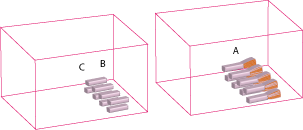| PHORONIDA: Collection, Preservation and Examination |
|
The easiest sampling is by Scuba-diving, in soft and on hard substrates. On soft substrates the best apparatus is a suction sampler (Emig, 1977). To prevent lophophore autotomy the phoronids must be fixed quickly after collecting. 
Identification of the adult species needs histological slides. Consequently the best fixative is a histological one, i.e. Bouin. Nevertheless formalin or alcohol may also be used but the specimens should be studied rapidly, although specimens stored for more than 8-10 years are usually impossible to identify because tissue deterioration.
Transversal slides at about 5-7 mµ at level A, B, C. Make continuous slides at level A. Some slides at B and C are enough. The characters for genus and species are listed below in relation with the three levels for identification.
For accurate identification on histological slides the best staining routine is Azan according to the Heidenhain’s method (see Emig, 1971, 1979). |
|
Emig C. C., 1971. Taxonomie et systématique des Phoronidiens. Bull. Mus. Nat. Hist. nat. Paris, (Zool.) 8, 469-568. Emig C. C., 1977. Un nouvel aspirateur sous-marin à air comprimé. Mar. Biol., 43, 379-380. Emig C. C., 1979. British and other Phoronids. In : Synopses of the British fauna, Eds Kermack D. M. & R. S. K. Barnes, Acad. Press, London, 13, 57 pp. |
| Diagnostic features of the adult genera | Section level | ||||||||||||||||||||
|
|||||||||||||||||||||
| Diagnostic features of the adult species | Section level | ||||||||||||||||||||
|
|||||||||||||||||||||
|
|||||||||||||||||||||
